30 Famous Landmarks of Switzerland (100% worth a visit)
Located in the heart of Europe, embraced by the borders of France, Italy, and Germany, Switzerland offers a unique opportunity to travel through diverse cultures and languages.
Famed for its heartwarming cuisine and a plethora of about 1,500 mesmerizing lakes, this small country is a cultural treasure trove, brimming with an array of captivating activities. Whether you’re a keen hiker, a snow enthusiast, or simply seeking idyllic landscapes, Switzerland is a destination that caters to every interest and offers an abundance of enchanting experiences.
Curious about the best highlights not to miss in Switzerland?
Here are the 30 most famous landmarks of Switzerland! 🇨🇭
Full List of the 30 Famous Switzerland Landmarks
To make it easier, we’ve divided the Swiss landmarks into 2 separate categories: first, the man made monuments, and then the natural sites.
🏛 Famous monuments in Switzerland:
- Chillon Castle
- Chapel Bridge
- Bellinzona Castles
- Oberhofen Castle
- St. Gallen Abbey
- Bern Old Town
- Grossmünster Cathedral
- Fraumünster Church
- Basel Minster
- Swiss National Museum
- Lake Geneva Water Fountain
- St. Pierre Cathedral
- Palais des Nations
- Lion Monument
- Bernina Express
- Landwasser Viaduct
- Gruyères Castle
🏔 Famous natural landmarks in Switzerland:
- Rhine Falls
- Matterhorn
- Aletsch Glacier
- Jungfrau
- Swiss Alps
- Lake Lucerne
- Pilatus
- Lake Geneva
- Lake Oeschinen
- Staubbach Falls
- Swiss National Park
- Mount Titlis
- Lake Lugano
So, here’s the list of the 30 famous landmarks Switzerland has to offer. To learn more and get details about each of them including the map, keep reading below👇
Famous Monuments in Switzerland
With its diversity of scenic beauty, interesting history, and preserved traditions, Switzerland offers a wealth of attractions and monuments, each with its own unique allure and appeal.
Let’s discover together 17 of the most famous monuments of Switzerland.
1. Chillon Castle
Not far from Montreux on the shores of Lake Geneva, in the town of Veytaux, lies a castle like no other.
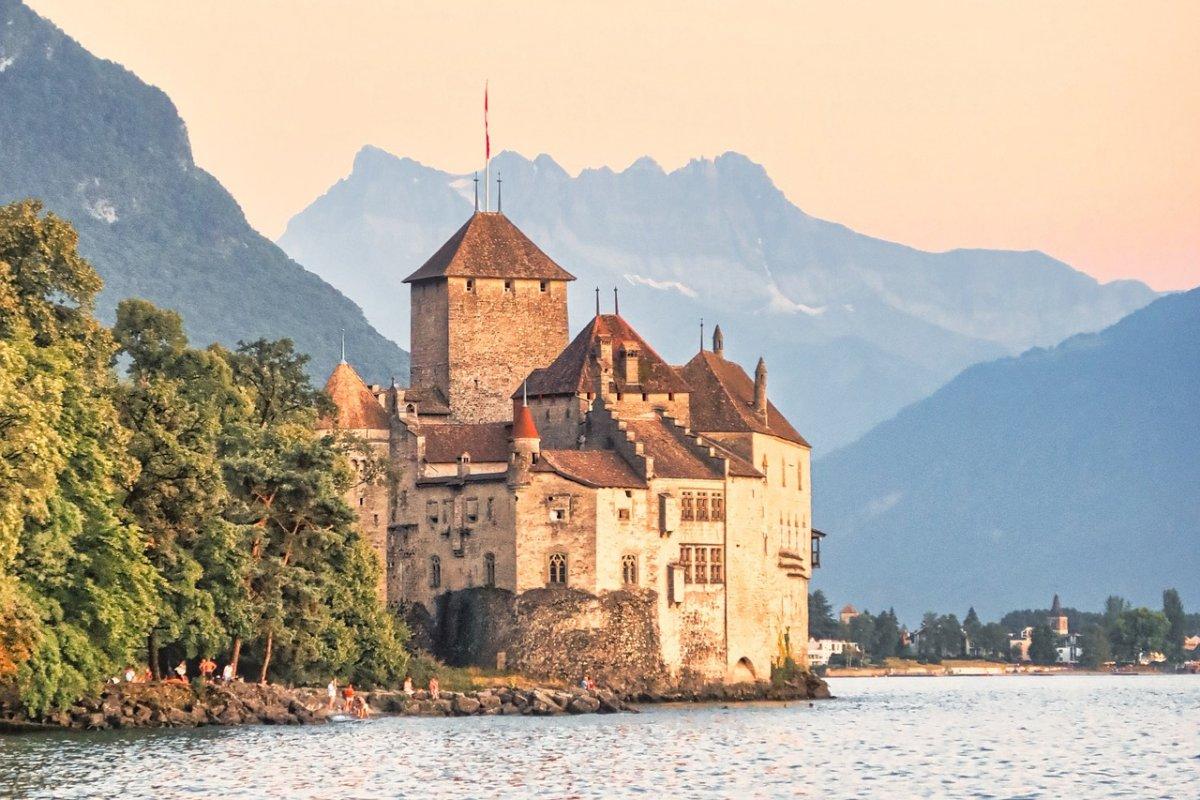
Chillon Castle, perched on a tiny island measuring 100 meters in length and 50 meters in width, is a remarkable fortress constructed in the 12th century by the House of Savoy. Its unique location gives the impression of it gracefully floating on water.
Now often used for cultural exhibitions, the castle tells the story of a whole part of Swiss history, with the takeover by Bern in 1536 and the Vaudois in 1798. With over 400,000 visitors every year, it has become the most visited historical landmark in Switzerland, captivating visitors with its beauty and rich heritage.
Best Deal: Montreux: Chateau Chillon Entrance Ticket
2. Chapel Bridge
Not to be missed on a visit to Lucerne, Chapel Bridge is one of the most photographed Swiss monuments. Stretching over 204 meters, it spans the Reuss River, beautifully linking the two banks that border the old town.
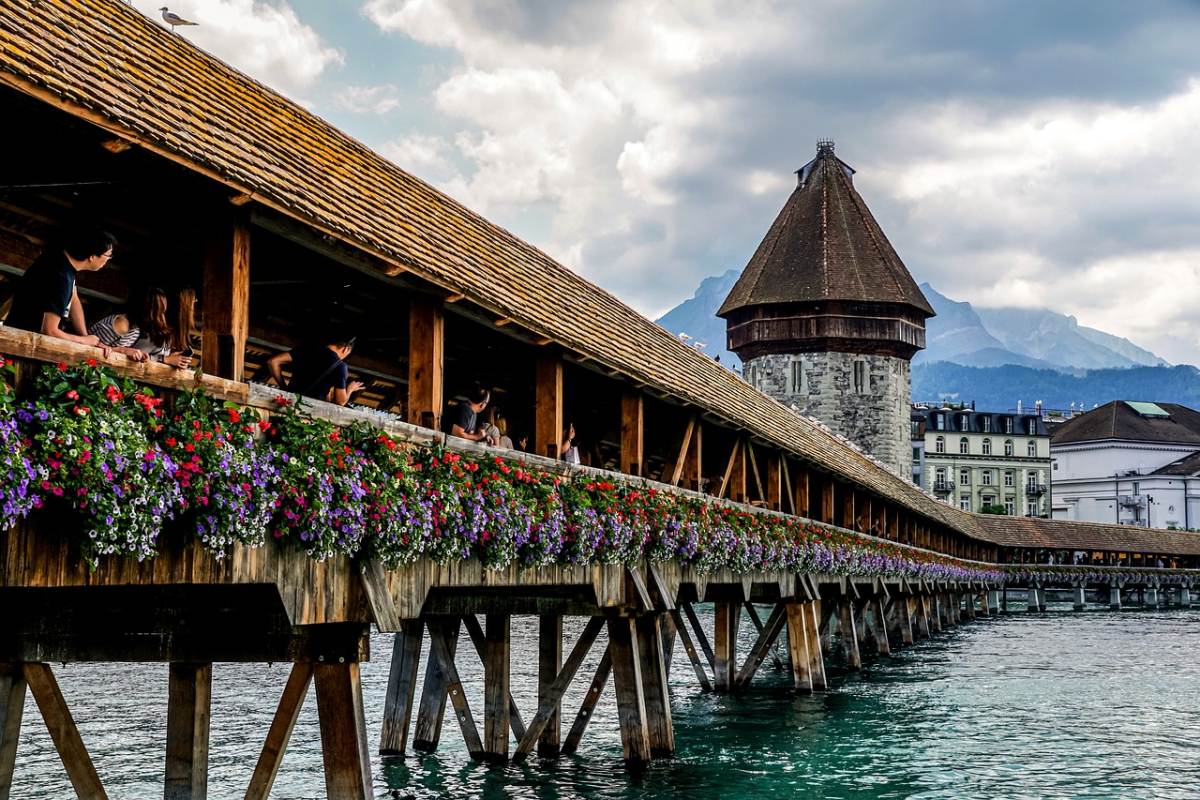
Also known as the Kapellbrücke, it’s the oldest covered wooden bridge in Europe. Its construction dates back to 1333 when it formed part of the city’s defensive fortifications. Throughout its history, it served various purposes such as a prominent city landmark, a refuge for lookouts, a prison, and even a torture chamber for enemies.
As you wander along the Chapel Bridge, take a moment to relish the splendid panorama that unfolds around you. I recommend you also cast your gaze upwards to discover the magnificent 17th-century paintings adorning the length of the bridge.
3. Bellinzona Castles
Recognized as an admirable example of medieval fortified architecture in the Alps, the castles of Bellinzona are the only Swiss fortress to be listed by UNESCO.

Perched in tiers above the town of Bellinzona, the castles of Castelgrande, Montebello, and Sasso Corbaro form a stunning ensemble, showcasing a breathtaking landscape. Built between the 13th and 15th centuries, these fortresses served as guardians of the strategic crossing point between northern and southern Europe.
As if straight out of a medieval tale, you’ll love walking along its ramparts, climbing its towers, and admiring the view over the town and surrounding area.
Best Deal: Bellinzona Pass: 3-Castle Ticket
4. Oberhofen Castle
Situated in the picturesque town of Oberhofen am Thunersee, this splendid fortress proudly stands on the shores of Lake Thun, with the Bernese Alps as a backdrop.

Founded in the early 12th century, this medieval castle set in a vast park boasts a magnificent keep and turret visible from the lake. First owned by the Eschenbach family, followed by the Habsburgs, and subsequently passed through the hands of several notable families, it was ultimately acquired by American William Paul Measey in 1925. In 2009, it became part of the Oberhofen Castle Foundation.
As well as offering breathtaking panoramas and a flamboyant garden, the castle now houses a museum that invites visitors to discover a number of divinely decorated rooms, including a Turkish smoking room and a knights’ hall.
5. St. Gallen Abbey
Built in 612 within the northeastern region of Switzerland, this awe-inspiring abbey shares its name with the town in which it stands. Throughout many centuries, it held a prominent position as one of Europe’s most significant Benedictine monasteries.
The abbey, which commemorates Gallus, is world-famous for its unique, delicate architecture, but above all for its library. Within its walls, a diverse collection of ancient works is housed, mainly consisting of original manuscripts alongside some transcribed between the 8th and 15th centuries.
The view from St. Gallen is simply breathtaking. Its 2-tower façade and rococo interior are magnificent and have earned it UNESCO World Heritage status.
6. Bern Old Town
Full of charm and endowed with a relaxed lifestyle that is quite rare for a capital city, Bern Old Town is simply magnificent.

The historic center has preserved its medieval urban structure dating from the 12th-14th centuries, which is the reason why it has been a UNESCO World Heritage Site since 1983. Its narrow streets and historic buildings, most of them made of Bernese sandstone, are indeed remarkably well preserved.
A visit to this old town is like stepping back in time. Some of its monuments are not to be missed on a day trip to Bern: the famous Clock Tower (Zytglogge), the Nydegg Fortress, and the Prison Tower (Käfigturm).
Best Tour: Bern: 90-Minute Stroll Through the Old Town
7. Grossmünster Cathedral
Also known as Zurich Cathedral, Grossmünster (“great abbey”) is Zurich’s largest church, easily recognizable by its twin neo-Gothic towers.

Located in the Niederdorf district, Grossmünster Cathedral serves as a prominent symbol of the city. Built in 1100, it has been renovated many times over the course of its history. Inside, the Giacometti stained glass windows will amaze you.
If you’ve got the legs and fitness to climb a hundred steps, don’t hesitate to climb the 187 steps of the Charlemagne Tower for a 360-degree view of the city, Lake Zurich, and the Alps.
8. Fraumünster Church
The Fraumünster Church is easily recognizable from its green-roofed clock tower, whose long spire pierces the Zurich sky.

Founded in 853 by King Ludwig the German for his daughter Hildegard, this convent was home to the women of the European aristocracy, but also had economic control of the city, minting coins and managing tolls. But the abbey was dissolved in the 16th century with the Reformation and became the property of the town.
Sober and elegant on the outside, its interior architecture is a veritable fusion of Romanesque and Gothic styles. What really catches the eye are the stained glass windows by Chagall and the gigantic organ.
9. Swiss National Museum
Housed in a beautiful medieval castle just opposite the central railway station in the heart of Zurich, the Swiss National Museum is a must-see for history buffs.
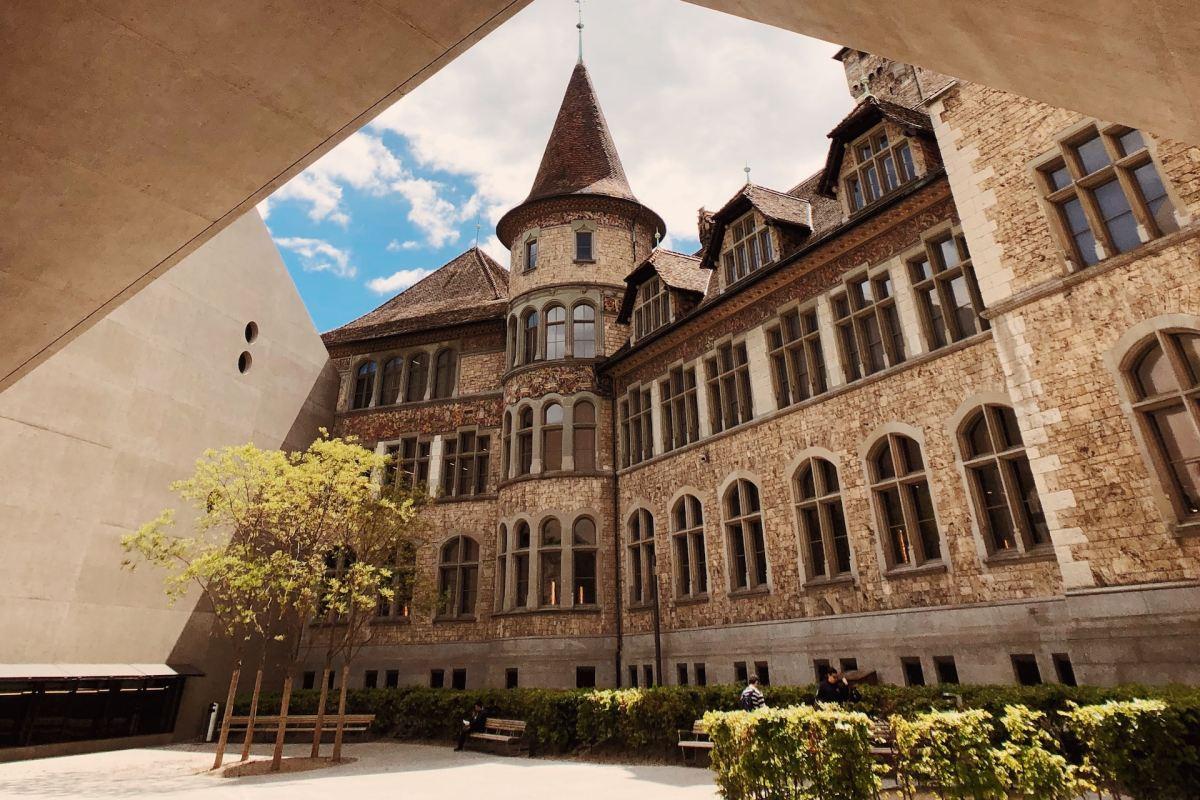
Locally known as the Landesmuseum, it boasts the country’s largest collection of historical artifacts. Discover Swiss culture through chronological exhibits, and learn how the country became a global financial hub.
Outside, the museum presents a striking contrast of ancient and contemporary architecture. Inside, the exhibits are truly captivating and well worth exploring. Bonus: admission is free with the Zurich Card!
10. Basel Minster
Basel Minster stands as an exceptional cathedral, distinguished by the use of red sandstone typical of towns built along the Rhine. But what makes it so singular is the irregular construction of its two towers. Overall, the architecture is breathtaking.
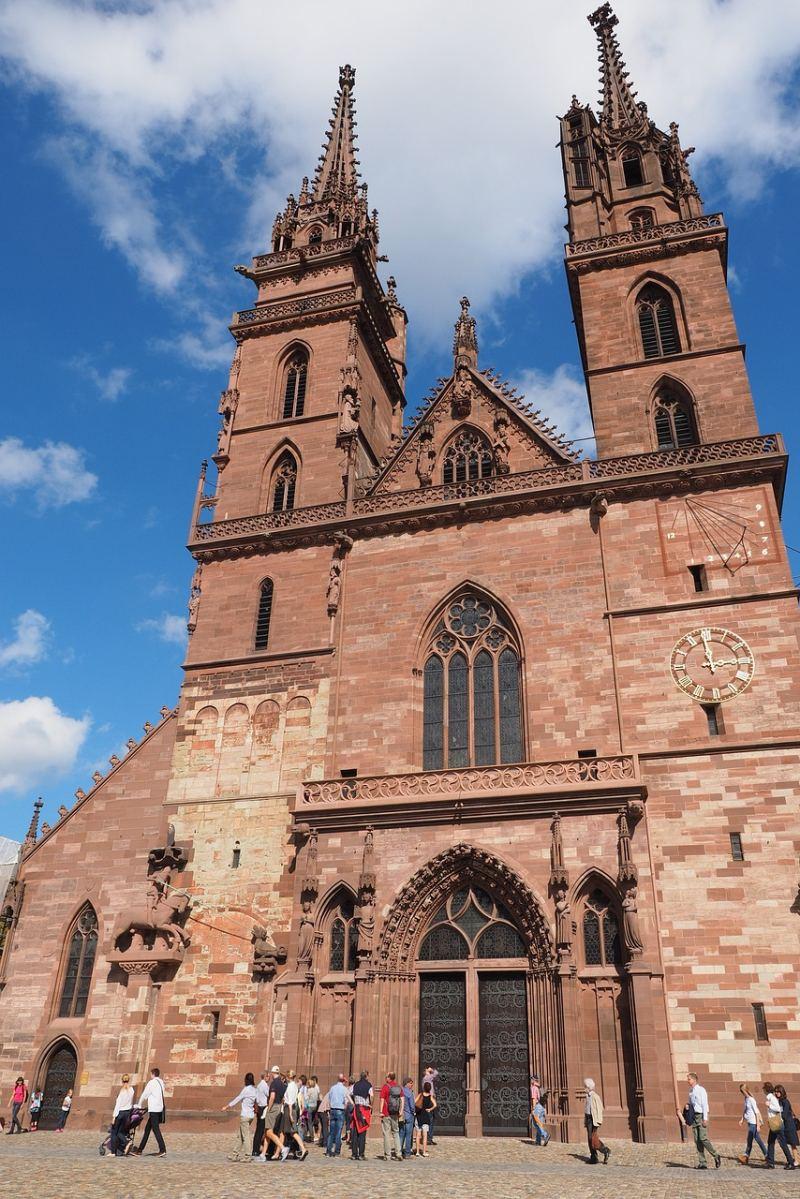
Built between 1019 and 1050 in Roman and Gothic styles, the cathedral was damaged in an earthquake in the 14th century. It was rebuilt and now houses the tomb of the world-renowned theologian, Erasmus. The church is also famous for its pulpit, crafted from a single block of stone.
This iconic symbol of Basel has amazing features, including the intriguing Murmuring Gate. Visitors can also climb one of the towers for the view.
11. Lake Geneva Water Fountain
Located on Lake Geneva (or Lake Leman), the Water Fountain known as the Jet d’Eau is the city’s most popular attraction.

For the record, the water fountain has been in service since 1891. It was originally built to regulate the waterworks pressure. The excess pressure gave rise to the Jet d’Eau. Since then, it has been a major tourist attraction and a symbol of the city.
Soaring to heights of up to 140 meters, propelled by an astonishing speed of 200 kilometers per hour, the fountain showcases a staggering flow rate exceeding 500 liters of water per second! No wonder it can be seen from so far away. But be aware if you’re visiting Geneva in winter as the fountain works from 10 am to 4 pm only.
Best Tour: Geneva City Tour and Boat Cruise
12. St. Pierre Cathedral
Located in Geneva’s Old Town, St. Peter’s Cathedral overlooks the city and offers a breathtaking view of the lake.

Founded in 1160 and completed a century later, St. Pierre Cathedral is the city’s oldest religious building. Following the Protestant tradition, the cathedral’s interior embodies simplicity and modesty, devoid of extravagant embellishments and opulent adornments.
Once inside, climb the 150 steps to the tower, where the view of Lake Geneva, the Jet d’Eau, and Mont Blanc (on a clear day) is well worth the detour. Additionally, the cathedral houses an archaeological site in its basement, adding a further layer of historical intrigue to explore.
Read more: The Most Famous Landmarks in Geneva
13. Palais des Nations
Serving as an emblem of world peace, the Palais des Nations is located in Geneva’s international quarter.

Nestled within Ariana Park, this complex of buildings has housed the United Nations Office since 1946, standing as the second-largest UN headquarters worldwide after New York. Within its premises, the Assembly Hall can accommodate an impressive gathering of up to 25,000 delegates to organize global peace.
Guided tours are available, allowing visitors to discover the stunning ceiling of the Human Rights and Alliance of Civilizations Room, as well as explore the park adorned with century-old trees.
14. Lion Monument
The Lion Monument (Löwendenkmal) is located in the beautiful town of Lucerne and is one of the city’s symbols.

This huge sculpture carved into the rock commemorates the death of Swiss mercenaries in the service of French King Louis XVI, during an attack on the Tuileries Palace (Paris) by revolutionaries in 1792. Beneath the dying lion is inscribed Helvetiorum Fidei Ac Virtuti, meaning “To the loyalty and bravery of the Swiss”.
Measuring an impressive 6 meters in height and spanning 10 meters in length, the monument draws crowds, but it’s very impressive and well worth a look.
15. Bernina Express
Of all the scenic trains in Switzerland, none is more popular than the Bernina Express, recognized as one of the most extraordinary rail journeys in the world.

The Bernina Express takes its name from the Bernina mountain, which rises to 4,048 meters, and at the foot of which lies the town of Chur, from where the line departs (or arrives).
Traversing the Swiss Engadine Alps, the railway line connects Chur with Poschiavo in Switzerland and Tirano in Italy. The 4-hour journey through no fewer than 55 tunnels and 196 bridges is so exceptional that it has been part of the UNESCO World Heritage since 2008. It’s possible to catch the Bernina Express en route at any of the intermediate stations, the most famous being Davos and St. Moritz.
Best Deal: Geneva: From Milan: Lake Como, St. Moritz & Bernina Train Day Trip
16. Landwasser Viaduct
As the Bernina Express crosses the Albula railroad, it crosses one of the most iconic man made landmarks in Switzerland known as the Landwasser Viaduct in the canton of Graubünden.
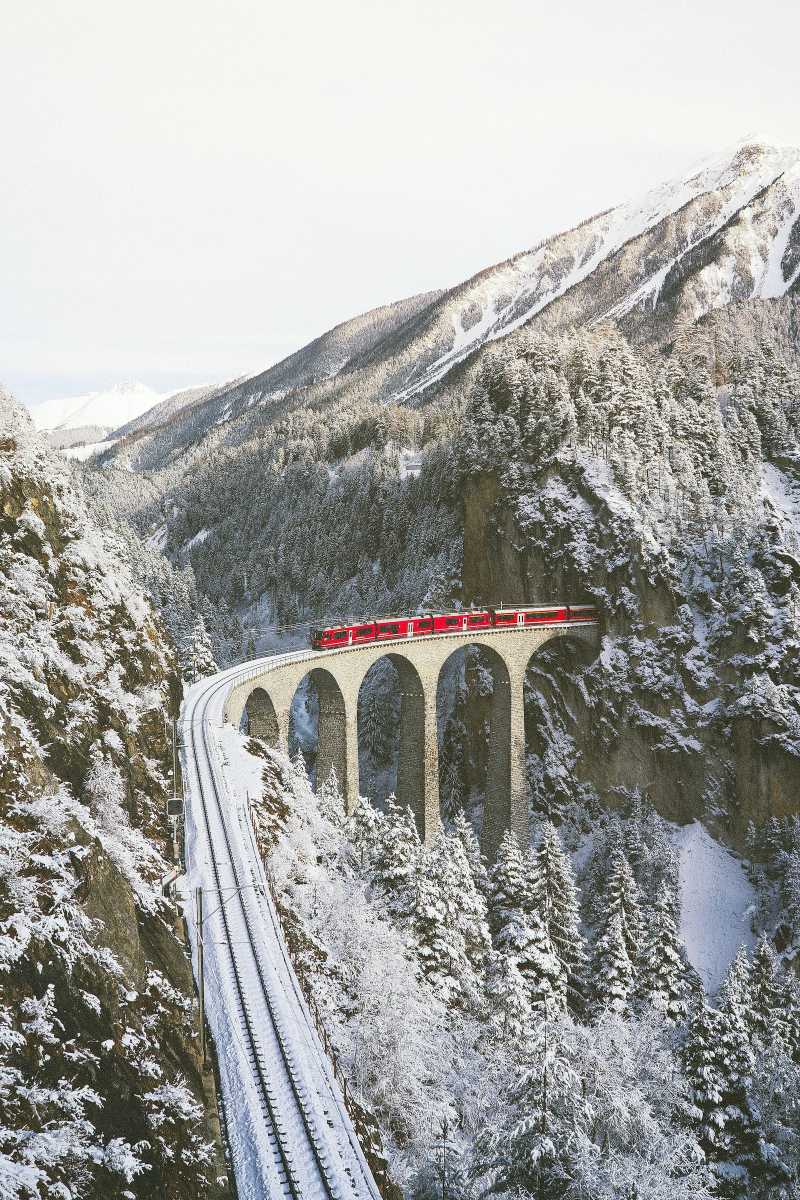
Completed and operational since October 1902, this remarkable viaduct stands as a testament to Switzerland’s engineering prowess and remains one of the world’s most renowned bridges. Reaching a height of 65 meters and a length of 136 meters, the viaduct is composed of 6 arches, each 20 meters long.
Spanning the Landwasser Gorge, this viaduct, recognized as a UNESCO World Heritage site, is remarkable for its graceful arcuate curve of a radius of about 100 meters.
17. Gruyères Castle
Gruyères Castle is built on a hill overlooking the magnificent Gruyères region. Located in the old town of Gruyères, it’s the second most visited castle in Switzerland after Chillon Castle.

Dating back to the 13th century, the Château de Gruyères seamlessly weaves together architectural styles and eras, transitioning from medieval to modern influences. After several transformations during the Baroque period, the château became an artists’ colony in the 19th century, welcoming renowned figures like French painter Camille Corot. This artistic tradition endures to this day, with the castle regularly hosting temporary exhibitions showcasing the works of contemporary artists.
Take a stroll through the old town of Gruyères to reach the castle. Inside, a rich array of paintings, wall decorations, a splendid knights’ hall, and a delightful garden await your exploration, providing a captivating journey through history and art.
Famous Natural Landmarks in Switzerland
Land of lakes and mountains, the whole surface of Switzerland is full of landscapes, each more incredible than the last. We’ve listed 12 of the most exceptional natural sites here (but the list could be much longer!).
Let’s go!
18. Rhine Falls
The Rhine Falls, situated on the Rhine River, lies approximately 40 minutes north of Zurich and stand as one of the largest waterfalls in Europe.

Formed some 15,000 years ago by tectonic movements that diverted the course of the Rhine, these falls are simply breathtaking. They are world-famous for their exceptional flow, with around 600,000 liters of water per second constantly sprinkling the bottom of the rocks during the summer season.
To discover this natural wonder, there are 2 access points: the Laufen Castle path and the Wörth House path. Whether you choose to admire the falls from the elevated viewpoint of Laufen Palace or from the front, the experience is truly remarkable.
19. Matterhorn
In the famous village of Zermatt, you can’t miss the Matterhorn. This majestic mountain stands tall at an elevation of 4,478 meters like a sharp, two-sided pyramid, with a seemingly dizzying ridge cutting through its center.
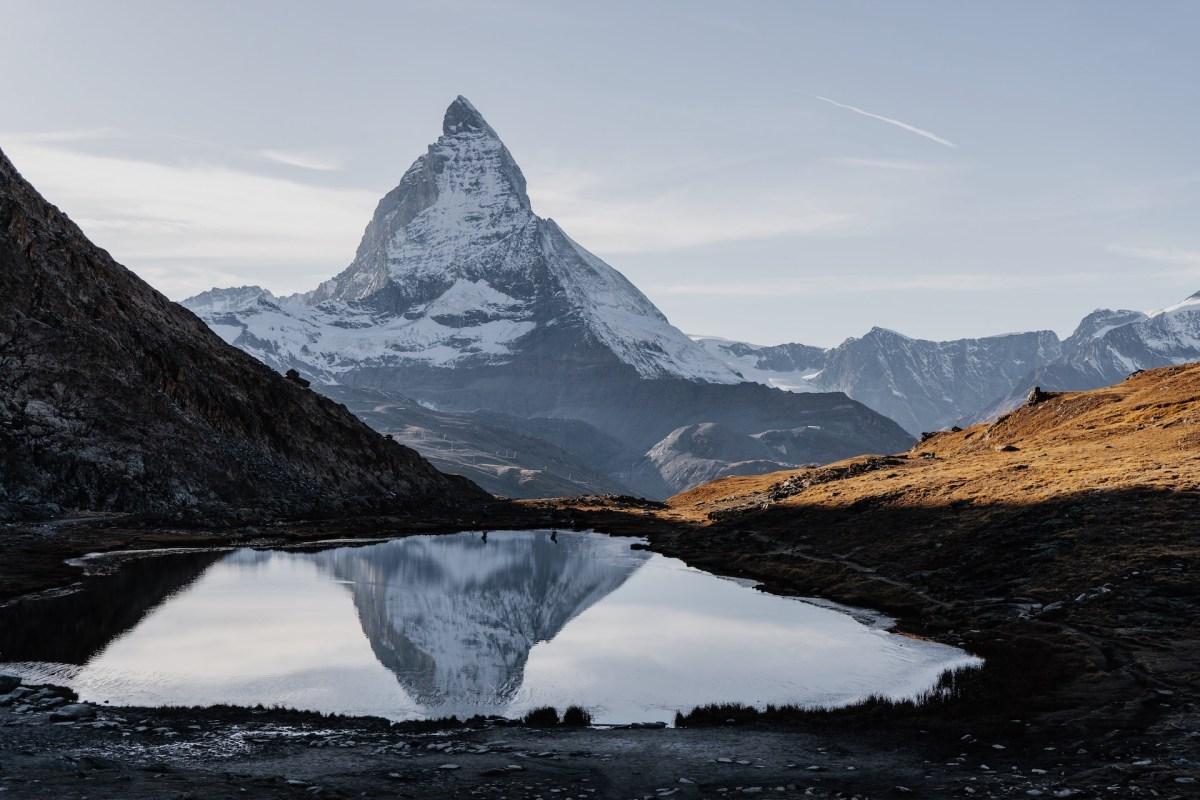
The Matterhorn was first conquered in 1865 by an expedition led by Edward Whymper. Sadly, of the 7 men who reached the summit, only 3 survived. Today, the peak is most famous for being the iconic symbol of the Swiss chocolate brand Toblerone, as well as a prime destination for board sports and hiking lovers.
To admire Switzerland’s most emblematic mountain at its most flattering, it’s best to get a bit of height by taking the 5-lake trail, a 3-hour loop from Blauherd to Sunnegga. And for a closer look, opt for the Matterhorn Glacier Trail, a 2-hour hike perched on the snow floor.
20. Aletsch Glacier
Located in the Valais canton between the Bernese Alps and the Rhone Valley, the Aletsch glacier is the largest glacier in the Alps and Switzerland.

This magnificent glacier stands as a Swiss marvel, comparable in significance to the iconic Matterhorn. Spanning an impressive 23 kilometers between the Jungfrau summit and the Rhone Valley, the Aletsch glacier boasts a spectacular expanse of 27 billion tons of ice, reaching a peak thickness of 900 meters.
If you’re worried about walking several hours to get close to the glacier, don’t be. Various lifts provide convenient access to the southern ridge above the glacier. From there, 3 main viewpoints—Moosfluh, Bettmerhorn, and Eggishorn—allow visitors to bask in the splendor of the glacier’s majesty.
21. Jungfrau
The Jungfraujoch is a pass in the Bernese Alps, reaching an altitude of 3,463 meters. It proudly marks the border between the cantons of Valais and Bern, forming part of a ridge extending from the Mönch to the Jungfrau.

Sphinx Observatory on Jungfraujoch
Home to Europe’s highest railway station, the Jungfraujoch is dubbed “Top of Europe.” It’s a well-known destination for mountaineering buffs and is renowned for its wonderful scenery. The magic of the area is such that it’s one of the few natural landscapes to be listed as a UNESCO World Heritage Site.
To get to the Jungfraujoch, you have to leave from Grindelwald, a famous mountain village 20 kilometers from Interlaken. The starting point for this tour is the Grindelwald Terminal, where a delightful 45-minute train ride awaits, transporting travelers to the wonders of the Jungfraujoch.
22. Swiss Alps
While we’ve already highlighted some of its famous sights like the Matterhorn and Jungfrau, we can’t fail to mention the entire Swiss Alps region which is nothing short of incredible in totality.

The Alps cover no less than 60% of Switzerland, stretching from Lake Geneva to the Austrian border. They are home to numerous glaciers and 48 peaks over 4,000 meters in altitude, the highest being the Pointe Dufour at a lofty 4,634 meters.
This rugged terrain is also home to lots of forests and a multitude of lakes, creating beautiful landscapes well worth visiting at any time of year. In summer, the region becomes a haven for road trippers and campers, while in the winter season, it attracts snow sports enthusiasts seeking thrilling adventures.
23. Lake Lucerne
Lake Lucerne is a glacial lake located in the heart of central Switzerland, between the cantons of Lucerne, Unterwalden, Schwyz, and Uri.

Spanning an impressive length of nearly 38 kilometers, this picturesque lake graces the region at an elevation of 434 meters, providing mesmerizing vistas of the surrounding mountains. With its clear and pure waters, Lake Lucerne is a great spot for swimming and various water sports, while also harboring diverse and abundant wildlife.
The region offers a variety of activities for all ages and tastes. Visitors can stroll along the lake’s shores, swim in its crystal-clear waters, soak up the sun on the sandy beaches, or fish in its depths. For hikers, a scenic trail meanders along the lake, unveiling breathtaking landscapes at every turn.
Best Tour: Lucerne: 1-Hour Cruise on Panoramic Yacht
24. Pilatus
Located about 20 minutes south of Lucerne, Pilatus is an Alpine mountain best known for its 48% cogwheel railway, the steepest in the world.
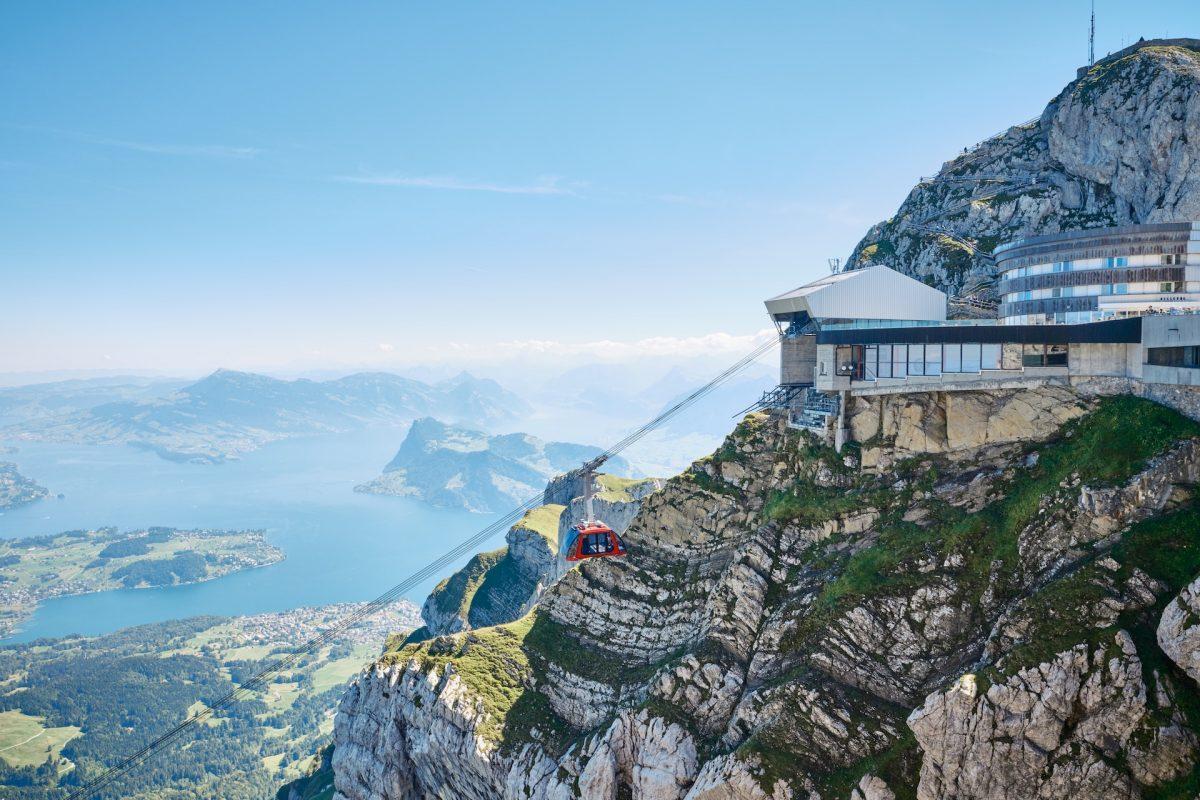
Ascending to an altitude of 2,132 meters, Mount Pilatus holds a historical significance as a worship site, intertwined with tales of dragons and legends that date back over 400 years. Among them, one tells the story of Pontius Pilate’s body and spirit resting in a lake atop the summit, leading to a centuries-long curse and a prohibition on climbing the mountain, punishable by imprisonment.
Today, this fear is no more, and Pilatus has become a popular tourist attraction where you can enjoy all kinds of outdoor activities.
25. Lake Geneva
Lake Geneva (or Lac Léman), the largest lake in the Alpine region, gracefully extends along the border of France and Switzerland. This expansive body of water takes the form of a crescent, spanning an impressive length of nearly 73 kilometers, with a maximum width of 14 kilometers.

Situated at an altitude of 372 meters, the Swiss shore boasts breathtaking views of the Alps and Mont Blanc and is home to a string of charming towns and villages, from Geneva to Montreux and Lausanne.
Blessed with a temperate climate, the lake offers an inviting setting for summer bathing, particularly at the Pâquis baths, located across from Geneva’s famous Jet d’Eau. You can also cruise its calm waters on a pedalo or motorboat, or take a stroll along the countless trails that surround it, marveling at the picture-postcard mountain scenery.
Best Tour: Geneva City Tour and Boat Cruise
26. Lake Oeschinen
Located above the village of Kandersteg in the Bernese Oberland, Lake Oeschinen is the only Swiss lake to be included on UNESCO’s World Heritage List.

Surrounded by sheer cliffs, this small lake nestles at an altitude of 1,578 meters and is fed by glacial streams from 3 neighboring mountains. What sets it apart and makes it truly remarkable is the ever-changing spectrum of blue-green hues it displays, influenced by the weather and shifting seasons.
The 25-minute hike from the Kandersteg cable car to Lake Oeschinen is just as magnificent as the lake itself, passing waterfalls, melting glaciers, and alpine meadows. Once you arrive at the lake, prepare to be captivated by the breathtaking panoramic views that unfold before you.
27. Staubbach Falls
With a drop of almost 300 meters, the Staubbach Falls is one of the highest free-falling waterfalls in Europe.
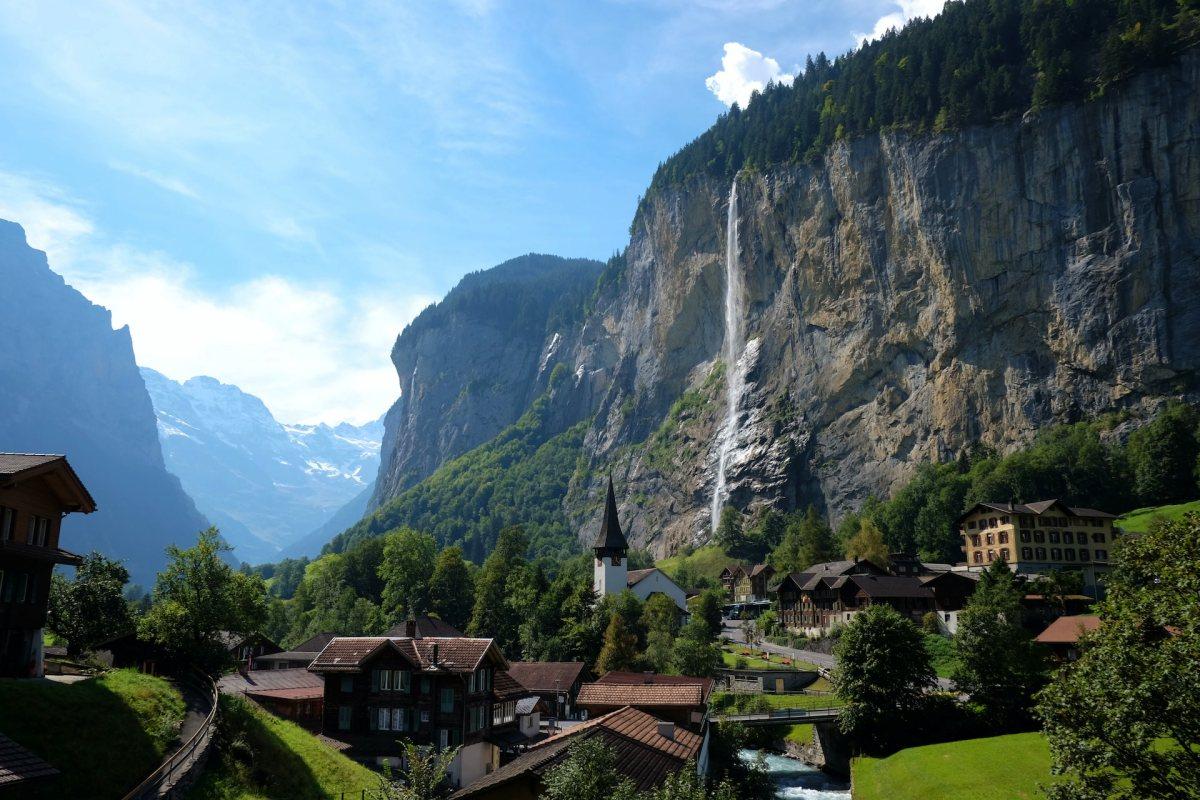
The Staubbach Falls is one of 72 waterfalls in the Lauterbrunnen Valley in the Jungfrau region, a UNESCO World Heritage site. In summer, hot winds whirl up the water drops, causing it to scatter in all directions like fine dust, thus earning both the torrent and the waterfall their evocative name.
For the record, it was this valley that inspired R.R. Tolkien’s creation of the Shire of the Hobbits. Also, the waterfall is the valley’s most Instagrammable spot: you’ve probably already seen this photo showing it plunging majestically down near a small church.
28. Swiss National Park
The Swiss National Park, the country’s only national park, is located at the eastern end of the canton of Graubünden, on the Italian border.

Established in 1914, the park was conceived with the aim of creating an authentic sanctuary for nature, where human intervention would be entirely absent. As a testament to this vision, the park is designated as a worldwide biosphere reserve, i.e. the highest level of protection.
There are 21 hiking trails in the Swiss National Park, varying in difficulty but all extremely well marked. Among them, the most renowned route is the Munt La Schera hike.
29. Mount Titlis
This peak in the Uri Alps, at almost 3,238 meters above sea level, may not be the largest or most prestigious in the country, but it does offer the opportunity to enjoy winter sports, as it’s an integral part of the Titlis ski area, considered one of the best in Europe.
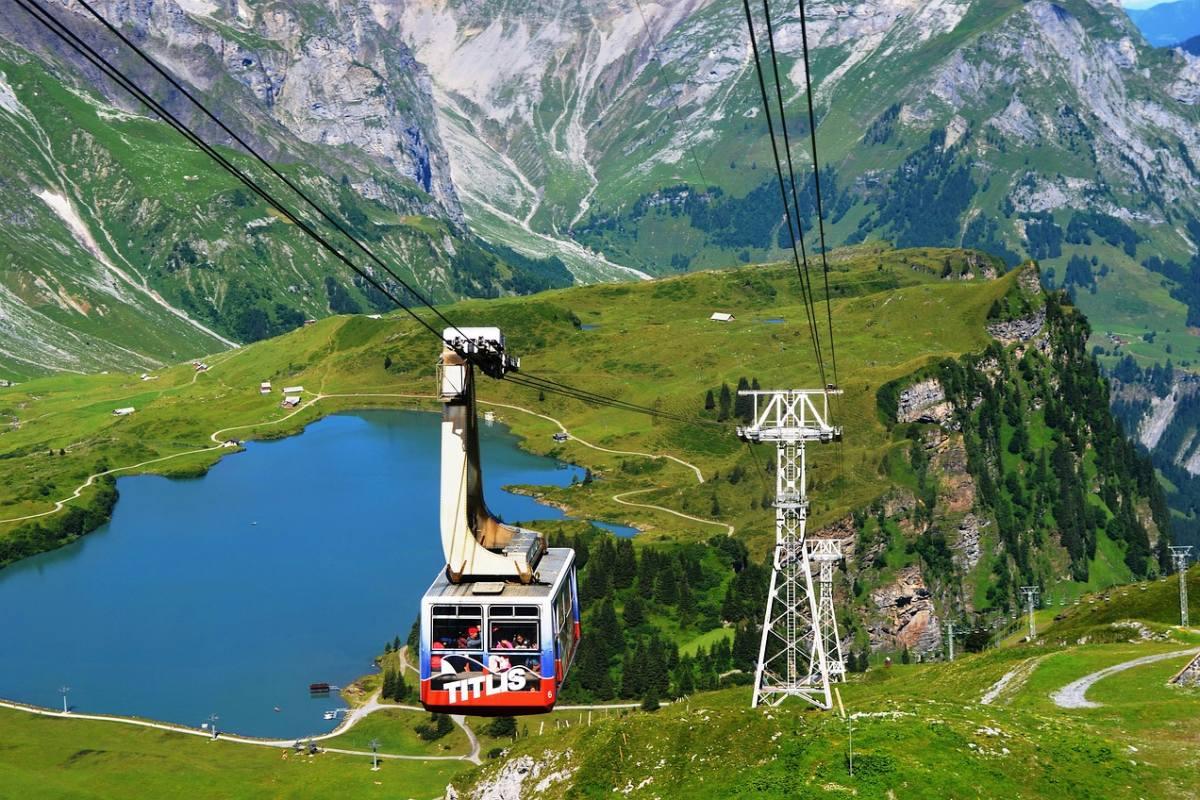
To reach the peak, all you have to do is take the Rotair in the town of Engelberg, a funicular railway with gyratory cabins that offers breathtaking panoramic views of the snow-capped Swiss mountains, valleys, glaciers, lakes, and forests.
Another of the resort’s undisputed attractions is the Titlis Cliff Walk. As Europe’s highest suspension bridge, it extends across a gorge that plunges almost 500 meters into the depths below, offering an exhilarating experience for those with a taste for adventure.
30. Lake Lugano
This lake, straddling Switzerland and Italy, is named after the beautiful city of Lugano and offers a warm Mediterranean change of scenery in the heart of the Alps.
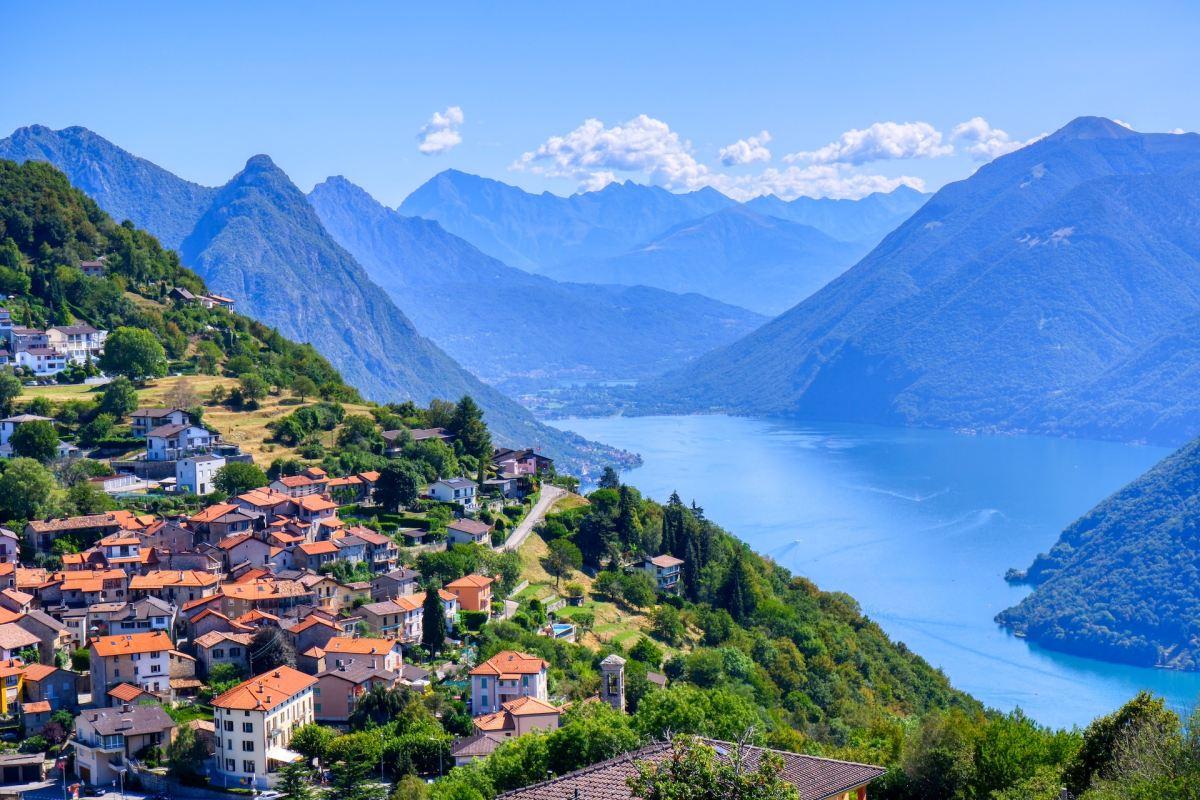
Embraced by majestic mountains, Lake Lugano unveils mesmerizing panoramas. Whether from its bay or from the Belvedere of Sighignola (known as the Balcone d’Italia), you can enjoy magnificent views of its blue waters.
The lake’s shores are home to several parks, as well as picturesque fishing villages such as Gandria, Castagnola, and Morcote. The best way to enjoy the lake’s wonders is to take the Olive Grove Trail, a 3-kilometer pathway that winds its way along the lake.
Map of the Famous Swiss Landmarks
Here is our map of the 30 best Switzerland monuments and landmarks listed in this post. To get it, simply click on the image below to open it in Google Maps. Then click on the “star” icon to save it to your own maps.
FAQ About the Famous Landmarks in Switzerland
What are 3 major landmarks in Switzerland?
In terms of popularity and global reputation, the 3 major landmarks in Switzerland are the Matterhorn, Chillon Castle, and the Rhine Falls. Although there are many other famous sites, these are the places that attract the most visitors and inspire travelers from all over the world.
Why should I travel to Switzerland?
While we could provide an extensive list of reasons to visit Switzerland, here are just a few to consider:
- Despite lacking a coastline, Switzerland showcases an unparalleled geographical splendor, featuring stunning lakes, winding rivers, and, above all, majestic mountains that are a haven for nature enthusiasts;
- Switzerland is a year-round destination, with each season offering a diverse range of attractions and experiences to enjoy, ensuring there is something for everyone’s preferences;
- The country’s gastronomy alone, with its delectable cheeses and chocolates, is a compelling reason to embark on a trip to Switzerland;
- With its central location in Europe and an exceptional transportation network, traveling to and from Switzerland is remarkably convenient, making it easily accessible and a breeze to explore.
And these are just a glimpse of the many more reasons that make Switzerland an enticing destination worth discovering!
I hope you could’ve completed your travel bucket list thanks to this guide of the best natural and historical landmarks in Switzerland. If you enjoyed it, don’t hesitate to share it or comment below, I love reading your feedback! 🙂
Before you go, here are more amazing world landmarks to discover:
- Famous Landmarks in France
- Famous Landmarks in the UK
- Famous Landmarks in Italy
- Famous Landmarks in Spain
- Famous Landmarks in Portugal
- Famous Landmarks in Greece
And even more on this page.
Travel Tools
Use any of our recommended links below to book your trip. You pay the same, and we earn a small fee; a great way to support us!
Pin this to Pinterest!
Enjoyed this guide? Then help a fellow traveler and pin it! They'll most definitely love you for it, 100% guarantee.







